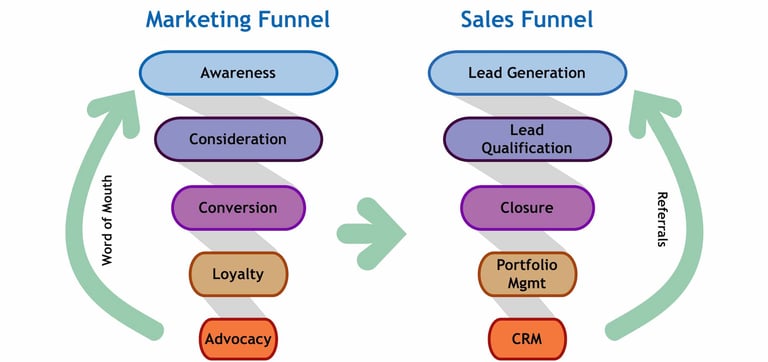Sales and Marketing.
Yup, it doesn’t take much to realise the ongoing rivalry between the two.
And as a founder - quickly get utterly frustrated by it.
After all, you know that both teams work towards the same goal. But somehow you just can’t get them to agree.
And if you’re tired of dealing with each side’s woes, then you’re in luck.
In this post, we’ll show you 5 ways to align your SaaS sales and marketing teams for success.
Intrigued? Then let’s get right to it.
Why the Sales and Marketing Enmity in the First Place?
You know:
When you think about it, the conflict between marketing and sales actually makes no sense.
Alignment between the two offers potentially the biggest opportunity to improve your business’ performance, and reach (or even exceed) your goals. Whether Inbound Marketing is the focus or traditional marketing, both departments must be on the same page.
After all, as Marshall Lager from Third Idea Consulting puts it:
“No matter how the CRM industry evolves, getting the sales and marketing teams to synergise is organisational goal number one. Every success grows from their collaboration and free exchange of ideas, because you can't serve the customer right when your best people are working blind.”
And yet, in spite of those benefits, the relationship between sales and marketing departments in SaaS companies looks awfully like this, doesn’t it?
Check out the following articles to learn more about SaaS Marketing:
- The Best Beginner's Guide to SaaS Lead Generation Today
- How to Innovate SaaS Marketing for 2023 and Beyond
- How to Convert SaaS Trial Users with Inbound Marketing
- Go to Market Strategy for SaaS: Tips and Best Practice
But have you ever wondered why?
In our opinion, the misalignment comes down to a lack of understanding how each team’s goals fit into the overall revenue generating strategy.
Marketers look at long-terms projects to attract potential users’ attention, raise the interest in your product, and generate high-quality leads.
Sales, on the other hand, is more interested in achieving results fast – turning leads into users to meet the quota.

The efficiency of SaaS sales reps within the sales process is crucial. However, the disconnect between the SaaS sales model and marketing activities often leaves sales teams struggling to translate their efforts into actual revenue. This misalignment leads marketers to question the effectiveness of the salespeople in the SaaS sales model.
As Phillip Kotler puts it in his article at the Harvard Business Review:
“Marketers judge their projects’ performance with a cold eye. But that performance focus doesn’t always look like action to their colleagues in Sales.”
Luckily, this friction is easy to overcome.
And here are a couple of ideas how you could do it in your SaaS.
1. Involve Sales People in the Marketing Strategy Ideation Processes
Although marketers might try to deny it, it’s true:
Sales people hold the key to reaching out and engaging your potential users.
How? Well, for one, enterprise sales reps actively engage with prospects every day, utilising the transactional sales model as part of their approach. Through this ongoing interaction, these sales reps gain valuable insights into the specific challenges that prospects are looking to overcome and discover what genuinely excites them about your product.
And coincidentally, that’s exactly the insight your marketing team desperately needs to create campaigns guaranteed to deliver the highest-quality leads.
However, ask any marketer and they’ll admit – sales people rarely share their insight.
As this article from Harvard Business Review puts it:
“Indeed, very few salespeople have an incentive to spend their precious time sharing customer information with Marketing. They have quotas to reach, after all, and limited time in which to meet and sell to customers.”
By including input from the sales people in the marketing strategy sessions, you can:
- Help marketers improve their output, by allowing them to work with real customer feedback
- Incorporate sales people in the development strategies that ultimately aim to deliver the most powerful asset they work with - leads.
2. Share Promotional Calendar with the Sales Team
We bet that a lot of the time, your sales people aren’t even aware of the offers marketers use to convert visitors into leads.
Heck, they probably don’t know which specific lead magnet grabbed a person’s attention and got them on your list.
As a result, they follow up using generic messaging, greatly missing out on the opportunity to engage leads with relevant information.
To overcome this, create a common promotion strategy calendar and share it with both teams to help sales people tie their responses to the actual offer a person’s downloaded.

3. Get the Sales People to Publish on your Blog
Tell us:
What’s the one thing EVERY sales person needs?
(Well, apart from more leads and closed sales, of course.)
It’s building their authority, and being perceived as an expert.
And what’s the easiest way to do it?
You got it - content.
The more you post, the more leads you can acquire.

So, get your sales team to publish on the blog.
This will bring mutual benefits for both teams:
- Marketing will get more content to publish to the site, and use to attract leads.
- Sales people, on the other hand, will get a chance to promote their knowledge and build assets they could use when interacting with prospects.
TIP: If your sales people don’t feel confident to write the content themselves, hire a ghostwriter (or even better, get the marketing team to ghost for them) to convert the person’s ideas into actionable content.
4. Invite the Marketing Team to Listen to Sales Calls
Facilitate a symbiotic relationship by having your marketers participate in the calls alongside the sales reps, particularly in the realm of enterprise SaaS sales. Emphasise that their involvement is voluntary; their role is to actively listen. This cooperative effort can yield invaluable insights into the prospects' needs, leading to a deeper understanding of the factors that drive monthly recurring revenue.
This will help your marketing team gain a much better insight into your potential customers’ minds, and in turn, create more relevant and engaging content.
It’s that simple.
5. Create a Sales Enablement Resource Database
Just like sales hold the key to customer insight, marketers are in control of materials the sales team needs to engage the future users for sales enablement.
Marketers work tirelessly creating various content types, article, eBooks, tutorials, and much more.
The problem? Sales people often don’t even know where to look for it.
In fact, according to CMO Council, sales people use only about 30% of the materials marketers create.
Consider adopting a self-service model as part of your SaaS sales strategy. This entails implementing a content management process that systematically categorises all marketing assets, benefiting everyone in the organisation. This approach streamlines the selling of SaaS throughout the sales cycle, resulting in a more efficient process overall.
ChartMogul is one example of a company utilising such a system to make every piece of content their marketing department produce available for everyone else in the company. (Note: You can find out more about their process from this conversation with ChartMogul’s head of content, Ed Shelley.)









